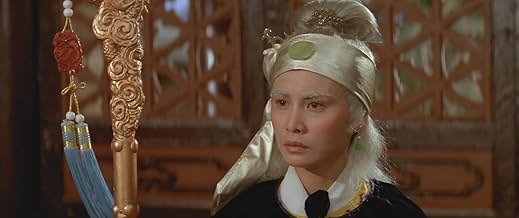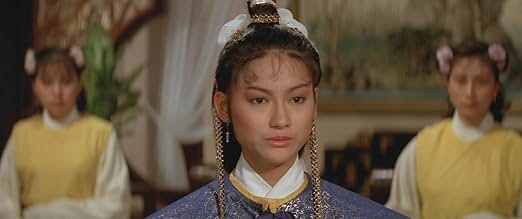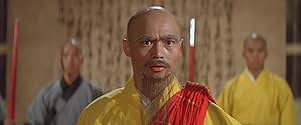Agrega una trama en tu idiomaMongols with the help of an insider, ambush the influential Yang Family, defenders of the dynasty. The Mongols must hunt down all Yang survivors so their insidious plot to overthrow the dyna... Leer todoMongols with the help of an insider, ambush the influential Yang Family, defenders of the dynasty. The Mongols must hunt down all Yang survivors so their insidious plot to overthrow the dynasty will not be uncovered.Mongols with the help of an insider, ambush the influential Yang Family, defenders of the dynasty. The Mongols must hunt down all Yang survivors so their insidious plot to overthrow the dynasty will not be uncovered.
- Dirección
- Guionistas
- Elenco
- Premios
- 1 nominación en total
- Yang Ba-Mei - 8th Sister
- (as Ying Hung Wai)
- Tartar Soldier
- (as Kuo-Chiang Chen)
- …
- Tartar Soldier
- (as Yung-cheng Chang)
- …
- Yang Erh-Lang - 2nd Brother
- (as Chia-Yung Liu)
- Dirección
- Guionistas
- Todo el elenco y el equipo
- Producción, taquilla y más en IMDbPro
Opiniones destacadas
A few years ago, I saw "The 36th Chamber of Shaolin" (1978), which I consider to be the next greatest martial arts film after the Bruce Lee masterpiece that is "Enter the Dragon" (1973). I must say that "The 36th Chamber of Shaolin" was the film to introduce me to what I call "straight-up old-school Shaw Brothers kung-fu." A year or so before I saw that, I had seen "Five Fingers of Death" (1972) (widely considered to be the first internationally successful martial arts film) and another Shaw Brothers classic, "Five Deadly Venoms" (1978).
Today, I had the pleasure to see yet another Shaw Brothers classic, "The 8 Diagram Pole Fighter," directed in 1984 by Hong Kong kung-fu master Liu Chia-Liang/Lau Kar-Leung (who also directed "The 36th Chamber of Shaolin" just six years earlier). Like the "The 36th Chamber of Shaolin" and many other martial arts classics, "The 8 Diagram Pole Fighter" is a story of revenge and retribution and redemption, with a strong Buddhist philosophical subtext warning against the evils of killing and taking lives under any circumstances.
Set during the Song Dynasty in China, the story concerns Fifth Yang (Gordon Liu, held over from "The 36th Chamber of Shaolin"), the only survivor along with Sixth Yang (the late Alexander Fu, who died in a car accident during filming and the film had to be extensively rewritten because of this) of the seven Yang sons, the loyal enforcers for the Song Dynasty. With the exceptions of Fifth Yang and Sixth Yang, all the Yang sons and their father were all either killed or captured by the Khitan-ruled Liao Dynasty army forces.
Sixth Yang makes it back home, but he's in a volatile deranged state that will make him unable to positively identify the primary culprit in the slaughter of his brothers and father, the traitorous Song Dynasty general, General Pun Mei (Ming Ku). Fifth Yang, however, now falsely labeled a fugitive and a traitor, makes it to a nearby Buddhist monastery in Mount Wutai, and insists that the monks take him in as their newest disciple. At first they are reluctant, due to his violent nature and revenge motives, but over time they grow impressed by his pole fighting skills and accept him as one of their own. But when he learns that his family is still in danger, he must join them - along with his sister Eighth Yang (Kara Hui, credited here by her birth name Ying Hung Wai) - despite the Buddhist vows of nonviolence that he has taken.
"The 8 Diagram Pole Fighter" is as exciting and action-packed as a Hong Kong-produced Shaw Brothers kung-fu classic can get. While the film does not approach the epic greatness of "The 36th Chamber of Shaolin" (which this film can probably be considered a companion piece to), "The 8 Diagram Pole Fighter" stands on its own two feet as yet another worthy kung-fu classic.
One of my biggest gripes is that I expected to see Gordon Liu's Fifth Yang to actually change his ways, and eventually have his revenge motives tempered by some greater desire to help others in need. That doesn't really happen here. While his character does indeed take his Buddhist vows very seriously (or at least gives the appearance that he does), he doesn't become a better person and still retains his violent nature and revenge motives. The other problem is that the monks sort of accept this and realize that they cannot truly change him. And while the monks do accept him as one of their own, it seems, to me, that the only thing they can really do is to harness his anger and try to channel it into non-lethal means (the whole business with wolves and their teeth, which you'll see if you watch the training sequences at the Buddhist monastery). Liu's character San Te in "The 36th Chamber of Shaolin" did not face these glaring ethical issues.
Maybe I'm reading things incorrectly here, so if anybody has any insight, feel free to correct me here.
On the plus side, "The 8 Diagram Pole Fighter" has some of the most extraordinary pole-fighting sequences ever filmed. I've never seen anything like it prior to this. And the film is also quite bloody, too, one of the most graphically violent martial arts films I've seen, in fact, since probably "Fists of Fury"/"The Big Boss" (1971) with Bruce Lee. And while the boys often get the most screen time here, Kara Hui's Eighth Yang proves to be a formidable kung-fu presence and can more than handle her own against the legions of disposable of bad guys sent in her general direction. In short, she's no damsel in distress - she's far from it.
Gordon Liu also delivers a powerhouse performance here. To know that Alexander Fu was originally supposed to be the lead here and with his tragic passing, the film had to be extensively reworked due to his death. Gordon Liu admirably stepped in his place to finish the film. Admittedly, it would be great to see what would have become of this film had Alexander Fu lived to complete it.
"The 8 Diagram Pole Fighter" is one of the best martial arts films I've ever seen. I'm glad that I had the opportunity to bask myself in its 97 minutes of epic kung-fu craziness.
8/10.
What I got was a decent but overly gaudy and loud ("aaaaaaarrrrgggghhhhhh!!!" all the time) movie. Lots of cool action, and (all things considered) a fair story, but I didn't really find it either believable or particularly memorable. The bad guys' pole-snagging device was extremely silly. I thought some of the costumes were good, but the chaotic way they fought (and screamed!!!) was too over-the-top and non-stop. Not much to be taken seriously, despite this not being (intended as) a comedy. I have seen many kung fu movies much better than this; I am not a great fan of the exaggeratedly flashy type of martial arts movies.
Still, this was not a bad movie, and I rate it a 7 out of 10.
This is a classic Shaw Bros. style film by famed director Lau Kar-Leung and starring Gordon Liu ("6th Brother"), whom Tarantino paid homage to by giving two roles in Kill Bill I & II.
The father of the Yang family and his seven sons go to battle to fight the Mongols who are threatening the Sung Dynasty. They are betrayed by a rival family and only two brothers, 6th (Liu) and 5th, survive. "6th" takes refuge at a General-turned-hunter's rural hideout (the General is a cameo by director Kar-Leung), before fleeing to a monastery where his brash personality conflicts with the monks there. At the monastery, he must improve his skills before seeking vengeance on those responsible for his family's betrayal.
The first fight scene (the battle) is a little cheesy with an obvious screened backdrop, a setting that doesn't really fit with the rest of the film. If the film was more ambitious this could have been a more impressive outdoor battle. But this is the film's only real drawback. The fights start out great and only get better. Highlights include 8th Sister's really breathtaking swordplay, and 6th Brother's duel with the Abbott which is both acrobatic and beautiful. This fight ends poetically, as during the fight both men had enscribed a yin-yang symbol on the floor of the monastery, symbolic of these two men's conflicting personalities: peaceful monk and warrior General.
The final scene is an all-out bloody melee which is really impressive, especially when 6th Brother takes on the horde with 8th Sister strapped to his back. Some of it is overacted (extreme reactions from bad guys as teeth are knocked out!) but used as a source of campy amusement, it only adds to the whole spectacle.
The plot is strong and very Shakespearean in scope (family loyal to the ruler is betrayed, family members must communicate in secret to avoid discovery while revenge is planned). The idea of the poles which use a twisty grappling-end to counter the Yang family's poles is unique. I love the fact that (like in many other films of the genre), the women's kung fu skills are as strong as the men's. This 20 years before the whole "girl power" thing in Western movies, music & TV.
If you're a fan of kung fu, see this film if you get a chance!
¿Sabías que…?
- ErroresThe film's story takes place during the Song Dynasty of China which lasted from year 960 to 1279. Yet when the 5th Yang insists on having his head shaved at the Temple, the monks are using a straight razor which was not invented until the 1700s.
- Citas
Abbot: Lord Buddha is against killing, under any circumstances.
Yang Wu-lang: [5th Yang approaching the Abbott] Look up at Buddha, and down at home.
Abbot: [Abbott raises his staff to the 5th Yang] Remember your vows... YOU CAN'T BREAK THEM!
- Versiones alternativasOriginally cut by the BBFC by around a minute for its original 18-rated 1984 cinema release and later on video. The cuts were waived by the BBFC for its 2020 Blu-ray release by 88 Films.
- ConexionesFeatured in Cinema Hong Kong: Kung Fu (2003)
Selecciones populares
- How long is The Eight Diagram Pole Fighter?Con tecnología de Alexa
Detalles
- Fecha de lanzamiento
- País de origen
- Idiomas
- También se conoce como
- Los ocho movimientos del dragón
- Locaciones de filmación
- Productora
- Ver más créditos de la compañía en IMDbPro
Contribuir a esta página






























